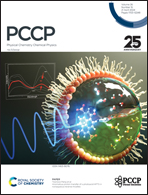Enhanced magnetic anisotropy of iridium dimers on antisite defects of two-dimensional transition-metal dichalcogenides†
Abstract
The combination of transition-metal (TM) elements with two-dimensional (2D) transition-metal dichalcogenides (TMDs) provides an effective route to realizing a 2D controllable magnetic order, leading to significant applications in multifunctional nanospintronics. However, in most TM atoms@TMDs nanostructures, it is challenging for the magnetic anisotropy energy (MAE) to exceed 30 meV when affected by the crystal field. Hence, the stronger magnetic anisotropy of TMDs has yet to be developed. Here, utilizing first-principle calculations based on density functional theory (DFT), a feasible method to enhance the MAEs of TMDs via configurating iridium dimers (Ir2) on 2D traditional and Janus TMDs with antisite defects is reported. Calculations revealed that 28 of the 54 configurations considered possessed structure-dependent MAEs of >60 meV per Ir2 in the out-of-plane direction, suggesting the potential for applications at room temperature. We also showed the ability to tune the MAE further massively by applying a biaxial strain as well as the surface asymmetric polarization reversal of Janus-type substrates. This approach led to changes to >80 meV per Ir2. This work provides a novel strategy to achieve tunable large magnetic anisotropy in 2D TMDs. It also extends the functionality of antisite-defective TMDs, thereby providing theoretical support for the development of magnetic nanodevices.



 Please wait while we load your content...
Please wait while we load your content...